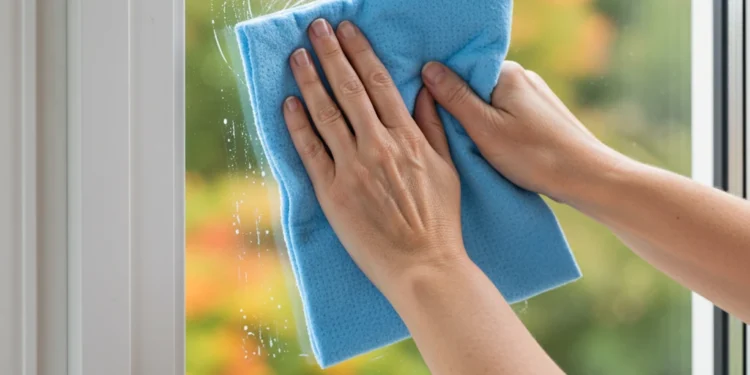Clean, streak-free windows make your home’s inside and exterior appear more polished. Eliminating dust, filth, and pollen from your windows will allow more light to enter your home. Furthermore, window manufacturers recommend keeping your windows clean to maintain the energy efficiency of any special coatings on the glass.
There are numerous suggestions for the best way to clean windows, ranging from newspaper to squeegees to sponges. A frequently requested question is “How do I avoid streaks?” You could pay for professional window cleaning services or purchase commercial window cleaning chemicals, but we’ve put together this complete guide to dispel cleaning myths and advise you of the simplest, most efficient, and most effective ways to clean your windows, both inside and out.
The 3 Most Common Mistakes When Cleaning Windows
If you finish cleaning your windows and they are coated in smears and markings, your initial thought might be that you are lacking a necessary tool, a better cleaning product, or a different technique. The actual cause is most often the opposite of what you would expect: people usually add too much to the cleaning process.
The most common cleaning mistake is overusing any cleaner. Because it only removes stubborn filth, cleaning chemicals are only needed in modest amounts. Too much window cleaner makes it hard to remove. Chemical residue left on the window after water evaporates causes streaks.
Going over it with hand towels or paper, which will leave lint behind, is the second most common mistake and the reason why windows look dirty after washing. If you use a hand towel or paper to clean your windows, pieces of the material are likely to fall off as everything becomes damp, leaving behind lint on the window.
Sunlight window cleaning is the third most common concern. Though tempting, cleaning windows on a sunny day is the worst. The sun will cause your windows to dry too rapidly before you have had a chance to rinse off any chemicals, leaving behind those horrible stains.
How To Clean Your Windows Correctly And Effectively
Enough about how not to clean windows. We’ve all heard it before: if you don’t have the correct tools for the job, everything will go wrong. It is the same when it comes to cleaning your windows.
A list of necessary items for washing your windows:
- Microfiber Cloths or Microglass Cloth
- A huge bucket full with clean water
- Spray Bottle
Regardless of the chemical you use, it is critical to follow any directions on the back of the container, particularly the suggested water-to-chemical ratio, and avoid over-applying the chemical to your windows. The cleaning chemical’s purpose is to release the surface tension of any dirt or grime on the surface, making it easier to remove throughout the cleaning process.
If you don’t enjoy using chemicals to clean, don’t worry; there are plenty of natural options.
Distilled vinegar is a popular choice for washing windows. This is more widely known as white wine vinegar, and many people swear by it for keeping their windows clean, clear, and streak-free. Vinegar can be mixed with water at a 1:10 ratio, which is one part vinegar to ten parts water. It can then be applied to the window with a damp microfiber cloth and washed with water.
If you don’t want to use a chemical cleaner but don’t like the sound of vinegar, you can use water instead. If you want to go a step further, you can use distilled water, which is devoid of minerals and other deposits that might ordinarily leave water spots or streaks on your windows after washing.
Clean The Interior Of Your Windows
Let’s start with the inside windows. First, apply your chemical solution to the center of the glass surface with your applicator or spray bottle. Rotate a damp microfibre cloth around the glass’s surface, from center to edge. Make sure to cover the entire window as evenly as possible.
After applying the cleaning solution, rinse the microfibre cloth thoroughly in a bucket of water, leaving it slightly damp. The microfibre or microglass cloth’s ultra-absorbent nature allows them to pick up all dirt, water, and cleaning chemicals from the window. If the window is properly cleaned, there should be no need to dry it.
Clean The Outside Of Your Windows
The next step is to clean the outside of your windows. Cleaning the downstairs windows from the outside should be quite simple and involve a very similar, if not identical, approach to cleaning the inside of your windows. It is best to replace the clean cold water in your bucket and the microfiber cloth you are using.
Outside windows are likely to be a little dirtier than interior windows since they are more exposed to the weather. In circumstances where the windows are unclean, you can do an initial cleaning, let them dry, and then repeat the process until they are pristine.
Conclusion
Keeping your windows shiny isn’t as difficult as you would think, and it can be made easier by following these five useful techniques. Remember, these methods are only for interior cleaning and for cleaning downstairs windows from the outside. Leave any difficult-to-reach windows that require a ladder to the professionals window cleaning services. As nice as it is to have clean windows, it is not worth risking your safety for.












